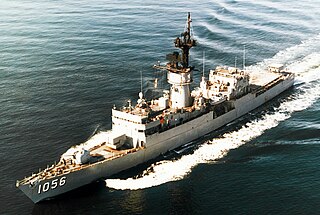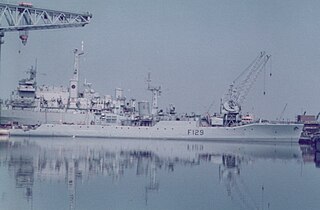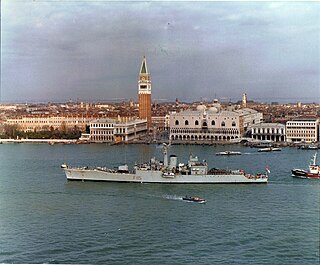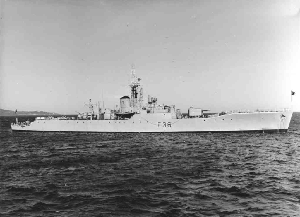Description
The Blackwood class displaced 1,180 long tons (1,200 t) at standard load and 1,456 long tons (1,479 t) at deep load. They had an overall length of 310 feet (94.5 m), a beam of 33 feet (10.1 m) and a draught of 15 feet (4.6 m). The ships were powered by one English Electric geared steam turbine that drove the single propeller shaft, using steam provided by two Babcock & Wilcox boilers. The turbine developed a total of 15,000 shaft horsepower (11,000 kW) and gave a maximum speed of 27 knots (50 km/h; 31 mph). [1] The Blackwoods had a range of 4,500 nautical miles (8,300 km; 5,200 mi) at 12 knots (22 km/h; 14 mph). Their complement was 140 officers and ratings. [2]
The ships were armed with three Bofors 40 mm guns in single mounts. The mount on the quarterdeck was later removed as it was unusable in heavy seas. They were equipped with two triple-barrelled Limbo Mark 10 anti-submarine mortars. The Blackwood-class ships had the same sonar suite as the larger Whitby-class frigates where the Limbo mortars were controlled by three sonars, the Type 174 search set, Type 162 target-classification set and the Type 170 'pencil beam' targeting set to determine the bearing and depth of the target. [3]

HMS Amazon was the first Type 21 frigate of the Royal Navy. Her keel was laid down at the Vosper Thornycroft shipyard in Southampton, England. The ship suffered a fire in the Far East in 1977, drawing attention to the risk of building warships with aluminium superstructure.

HMS Danae was a Leander-class frigate of the Royal Navy. She was, like the rest of the class, named after a figure of mythology. Danae was built by Devonport Dockyard. She was launched on 31 October 1965 and commissioned on 10 October 1967.

HMS Mohawk was a Tribal-class frigate of the Royal Navy in service from 1963. She was named after a tribe of Native Americans located in southeast Canada and New York State. Mohawk was scrapped in 1983.

HMS Torquay was a Type 12 Whitby-class frigate of the British Royal Navy. They were the first frigates to have the "V" form hull. This evolutionary design made it possible to be driven in head sea without the usual slamming which occurs with conventional destroyers of the time. Each frigate cost 3.5 million pounds and the first ship completed was Torquay in May 1956.

USS Connole (FF-1056) was a Knox-class frigate, named for Commander David R. Connole, Captain of USS Trigger when the submarine was lost in battle in March 1945.

HMS Blackwood was the name ship of her class of second-rate anti-submarine frigates built for the Royal Navy in the 1950s.

HMS Grafton was one of a dozen Blackwood-class frigate of second-rate anti-submarine frigates built for the Royal Navy in the 1950s.

HMS Keppel (F85) was one of a dozen Blackwood-class frigate of second-rate anti-submarine frigates built for the Royal Navy in the 1950s. She was named for Augustus Keppel, who served during the Seven Years' War and was admiral of the Western Squadron during the American War of Independence.

HMS Palliser (F94) was one of a dozen Blackwood class frigates of second-rate anti-submarine frigates built for the Royal Navy in the 1950s. She was named for Hugh Palliser, who served during the Seven Years' War and was First Naval Lord during the American War of Independence

HMS Pellew (F62) was one of a dozen Blackwood-class frigate of second-rate anti-submarine frigates built for the Royal Navy in the 1950s. She was named for Israel Pellew, who served during the French Revolutionary and Napoleonic Wars. He was brother to Edward Pellew, 1st Viscount Exmouth

HMS Rothesay was the lead ship of the Rothesay or Type 12M class of anti-submarine frigates of the British Royal Navy. She was commissioned in 1960 and scrapped in 1988.

HMS Londonderry was a Rothesay- or Type 12-class anti-submarine frigate of the British Royal Navy in service from 1960 to 1984.

HMS Brighton was a Rothesay or Type 12I class anti-submarine frigate of the Royal Navy.

HMS Falmouth was a Rothesay-class, or "Improved Type 12", anti-submarine frigate built for the Royal Navy during the 1950s. She took part in the Third Cod War in 1976, ramming the Icelandic gunboat V/s Týr. Both ships suffered extensive damage.

HMS Rhyl was a Rothesay-class or Type 12I anti-submarine frigate of the Royal Navy, launched by Lady Macmillan on 23 February 1959 and commissioned in October 1960. Following Royal Navy service she was scuttled whilst being prepared as a target in 1985.

HMS Lowestoft was a Rothesay-class or Type 12 class anti-submarine frigate of the British Royal Navy. Lowestoft was reconstructed in the late 1960s to largely the same pattern as the third group of Leander-class frigates, with new radar and fire control and a hangar and pad for a Westland Wasp helicopter for longer range, anti-submarine, engagement. In the late 1970s it was converted as the prototype towed array frigate for the Royal Navy, but retained its full armament. Lowestoft was sunk as a target on 8 June 1986 by HMS Conqueror using a Tigerfish torpedo. She was the last Royal Naval target to be sunk still displaying her pennant number.

HMS Berwick was a Rothesay- or Type 12I-class anti-submarine frigate of the British Royal Navy. She was built by Harland & Wolff and launched on 15 December 1959.

HMS Tenby was a Whitby-class or Type 12 anti-submarine frigate of the Royal Navy of the United Kingdom.

HMS Whitby was a Whitby-class or Type 12 anti-submarine frigate of the Royal Navy of the United Kingdom built by Cammell Laird and Co Ltd, Birkenhead. She was launched on 2 July 1954 and commissioned on 10 July 1956.

The Dealey-class destroyer escorts were the first post-World War II escort ships built for the United States Navy.
This page is based on this
Wikipedia article Text is available under the
CC BY-SA 4.0 license; additional terms may apply.
Images, videos and audio are available under their respective licenses.




















